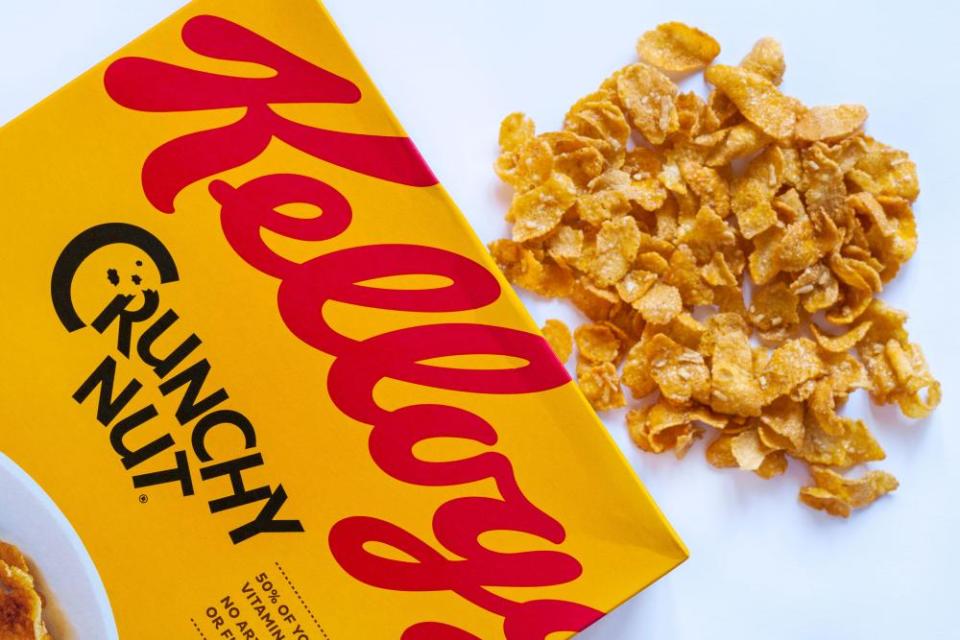Shrinkflation bites: popular food brands quietly downsize while charging same price or more
You’ve heard of inflation but what about “shrinkflation”?
Shrinkflation is a term coined by economists more than seven years ago but the process is becoming an increasingly common response to inflationary pressures.
Popular food brands are quietly reducing the size of their products sold in Australian supermarkets without decreasing prices accordingly, new research has found.
Data released by consumer advocacy group Choice shows companies including Nestle, Kellogg’s and Cadbury have shrunk their product sizes while charging the same price or more for the items.
Less is more at Cadbury, with its new chocolate block range, More, branded a case of shrinkflation by the consumer group.
Related: Markets turmoil and interest rate rises: the economic challenges facing Australia after the election
The 165 gram blocks, which come in a variety of nuts, fruit and salted toffee flavours, have been retailing at major supermarkets for $5, the same price as Cadbury’s regular 180 gram Dairy Milk blocks.
A spokesperson for Cadbury owner Mondelez said the More blocks featured a new shape with extra ingredients and a “chunkier” eating experience – making them more expensive to produce.
“The new More range is a fresh, indulgent take on some familiar favourites,” they said.
“The blocks feature a … chunkier eat experience, hence the different size. The new range also includes more inclusions, such as nuts and fruit pieces, than our original … blocks.”
The Choice journalist Liam Kennedy said there had been community tip-offs that “the heft” of products had shrunk while prices had increased, sparking its investigation.
“Overhead costs are increasing … there’s been classic inflationary pressures that have put the squeeze on manufacturers and brands,” he said. “The issue does seem to be coming to the fore.”
Major cereal brand Kelloggs has also been accused of shrinkflation.
Since 2019, the company had moved from selling 670 gram Crunchy Nut boxes for $6 to selling 640 gram boxes at $9 a pop, Choice found.
Kennedy said consumers had gone from paying $0.90 per 100 grams of cereal to $1.41 – a 57% increase.
Froot Loops had also downsized from 500 gram boxes to 460 gram packages while selling around the same price of $9.

Gary Mortimer, a professor of marketing and consumer behaviour at the Queensland University of Technology, had conducted experiments into the “shrinkflation effect” on shoppers and said it was “surprising” to see a package size reduction alongside a retail price increase.
“Putting prices up is always risky as a brand … [but] shrinkflation is rarely noticed in the marketplace,” he said.
Mortimer’s research found shoppers “don’t like price increases at all” but were more accepting of reductions in package sizing. “Shoppers prefer shrinkflation over inflation,” he said. “They’re sensitive to price not contents.”
Email: sign up for our daily morning briefing newsletter
App: download the free app and never miss the biggest stories, or get our weekend edition for a curated selection of the week's best stories
Social: follow us on YouTube, Facebook, Instagram, Twitter or TikTok
Podcast: listen to our daily episodes on Apple Podcasts, Spotify or search "Full Story" in your favourite app
Even more palatable was a perceived discount. Mortimer’s research found a 38% increase in sales when product size was reduced along with prices. “Customers felt they were getting a bargain because the price went down,” Mortimer said.
Mortimer said while shrinkflation was not a new concept, manufacturers would be looking at it as “the only strategy” to keep costs down in a volatile climate.
“As we’re becoming more sensitive to food price and inflation, most consumers would rather pay the same for their grocery bill,” he said.

“When brands implement a content reduction strategy most customers don’t notice they’re getting 25 or 30 grams less.”
Pet food label Purina One, owned by Nestle, said it had been forced to shrink the size of its products to keep them affordable.
The brand has been spruiking its updated range of dry adult cat food products, featuring a “new and improved recipe” to bolster immune systems and improve feline health.
But most new versions of the product were no longer available in the standard 1.5kg packaging the original came in – it was now sold in 1.4kg bags at an increased price.
A spokesperson for Nestle said the company had been facing “significant increases” in the cost of raw materials, packaging and transport which accounted for the price rises and changes in packaging sizes.
In the past, owners shopping for their feline friends would have nabbed the 1.5kg originals at a recommended retail price of $15.45. But the smaller products were now selling for $16.50 at major supermarkets.
A spokesperson for Nestle said over the past two years, the company had worked on an “improved formulation” for its Purina One range with all products now including a “specialty designed blend” to support the immune response of cats. Changes had also been made to kibble.
“In some instances, we decreased the size of the bag, to ensure we can continue to deliver the same quality products at an affordable pack price,” they said. “For some variants we have also introduced larger bags which offer better value.”
Kennedy said a surefire way to spot shrinkflation was to pay attention to the weight and size of a product, as well as the unit price per 100 grams.
“You’ll start noticing if they start shrinking,” he said.
“If a product undergoes simultaneous changes in size and cost, the unit price can tell you if you’re still getting the same value for money as you were before.”
Kellogg’s was approached for comment.

 Yahoo Movies
Yahoo Movies 
